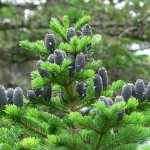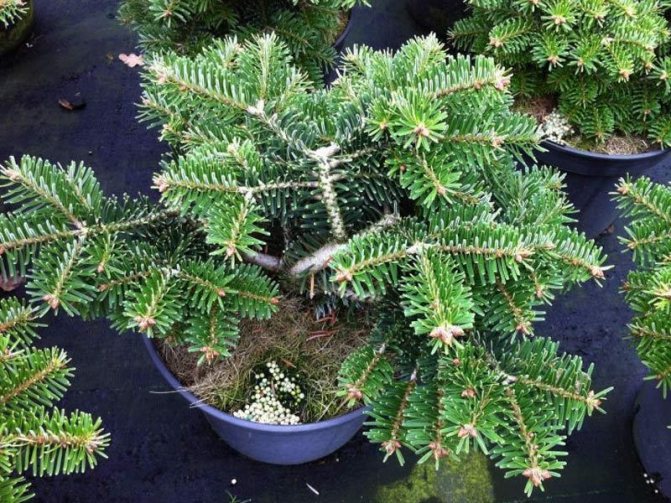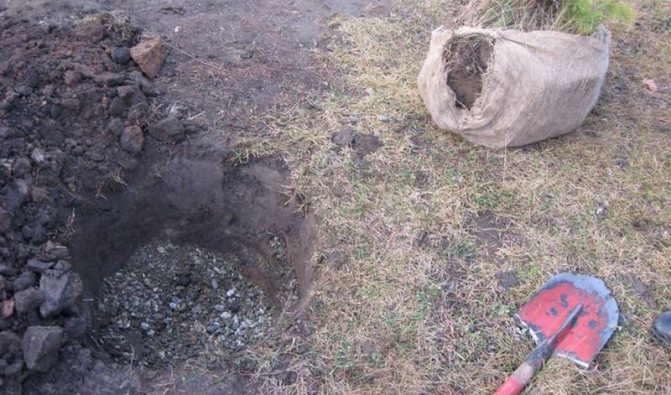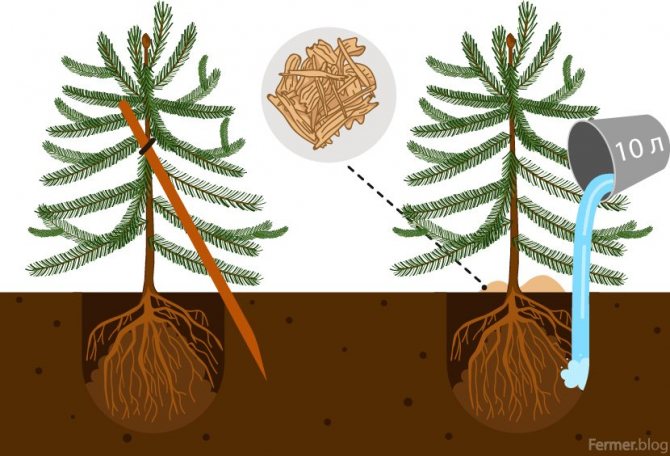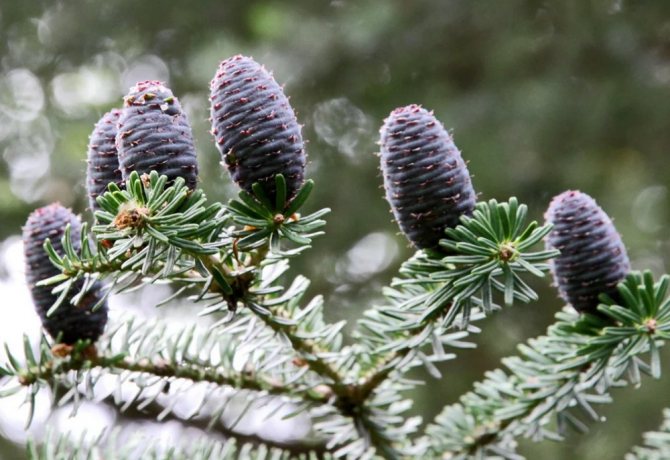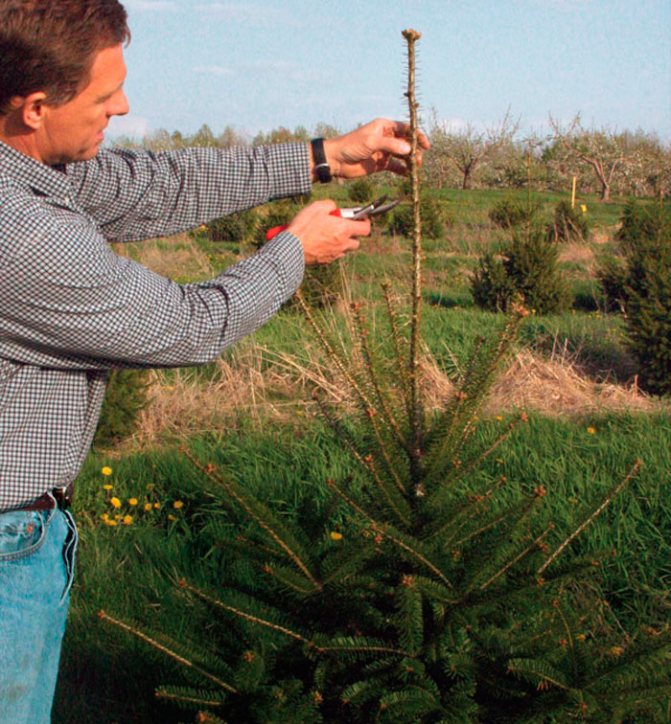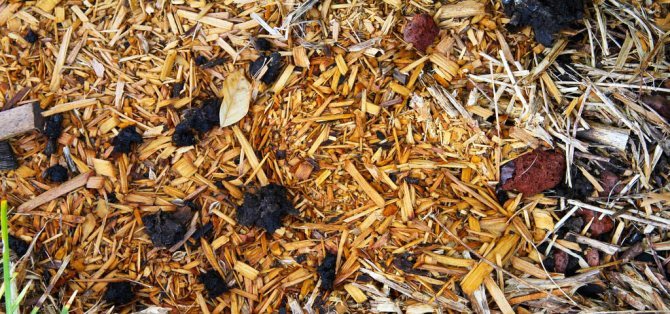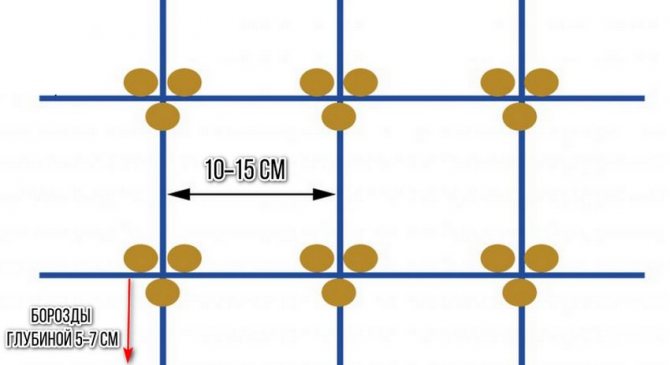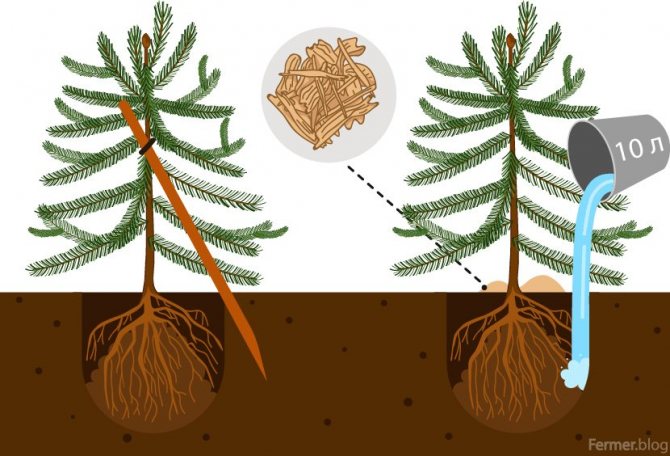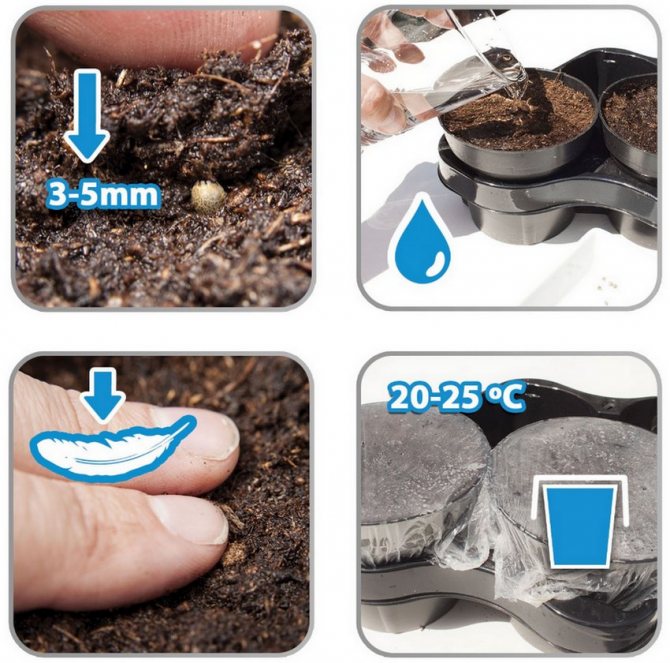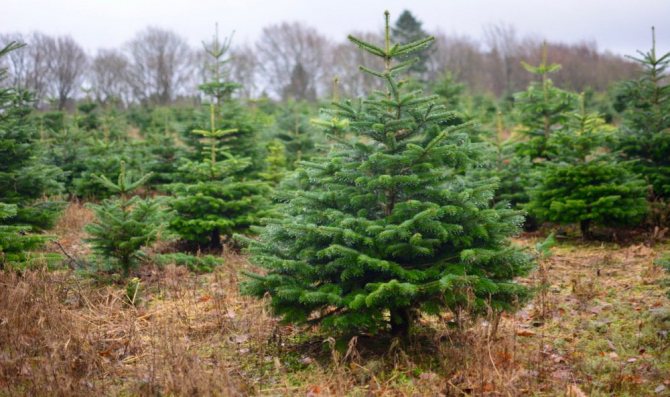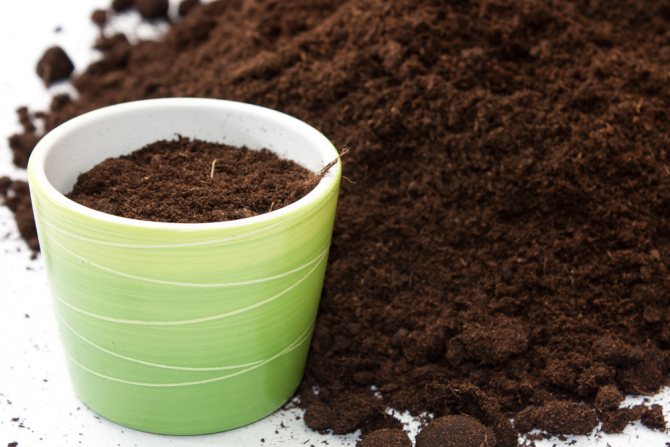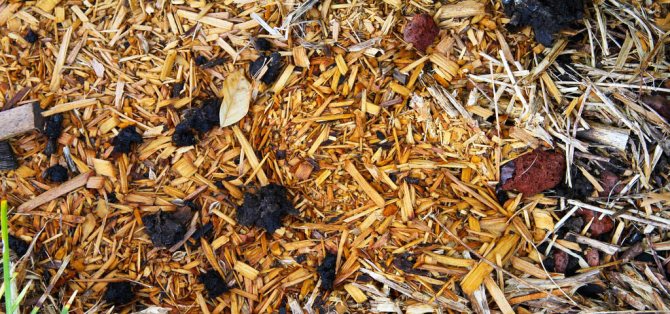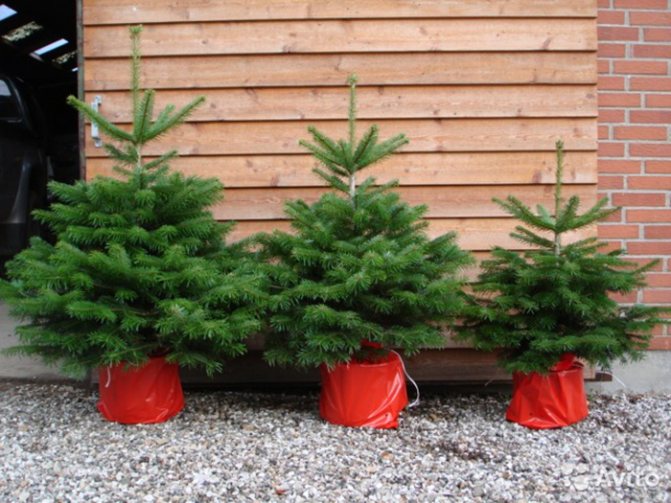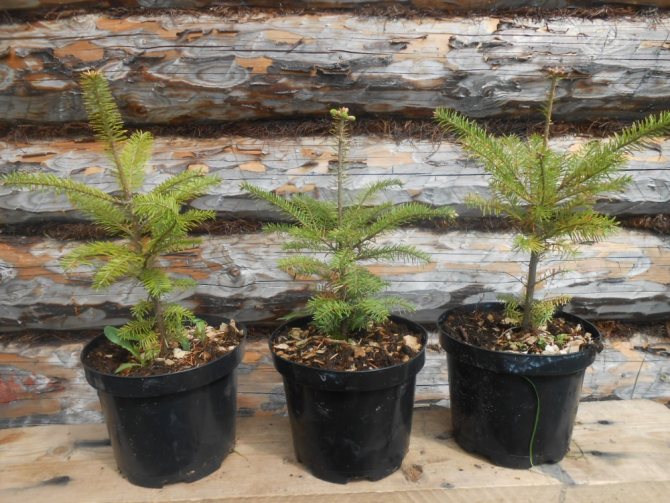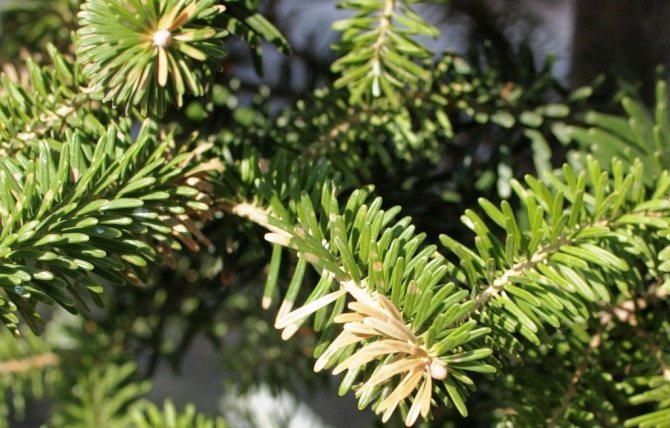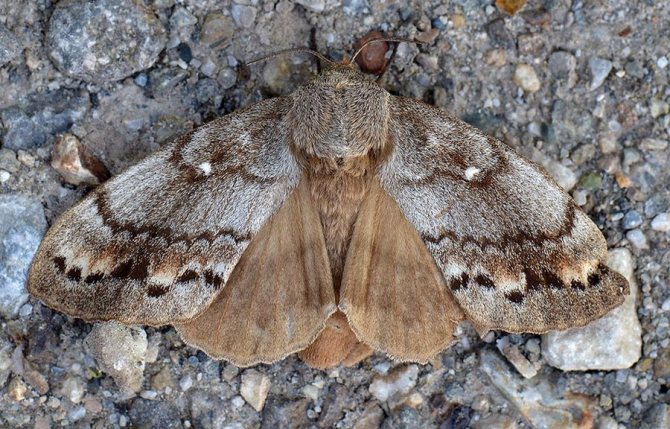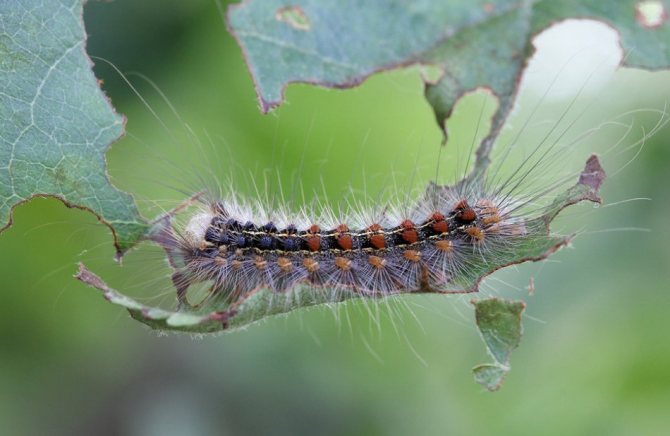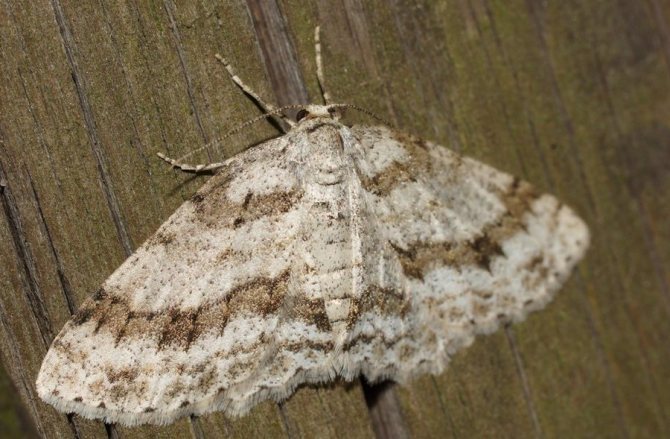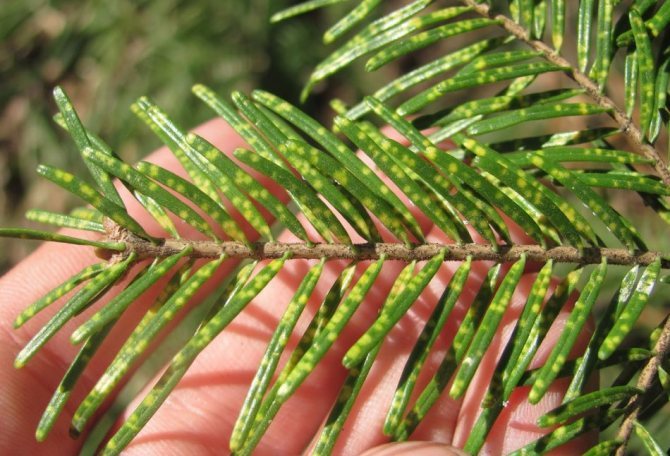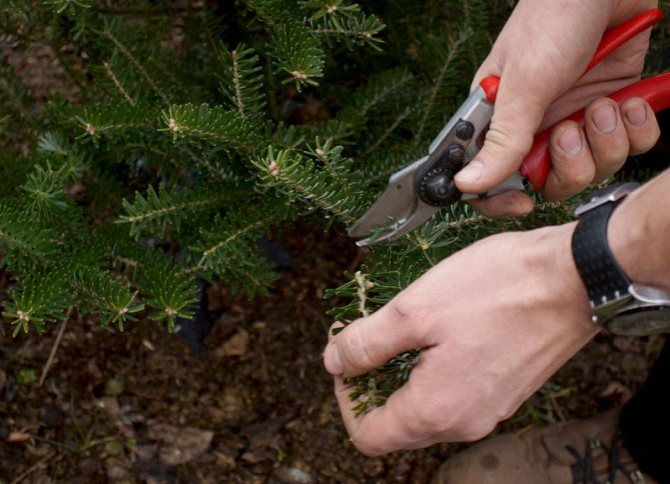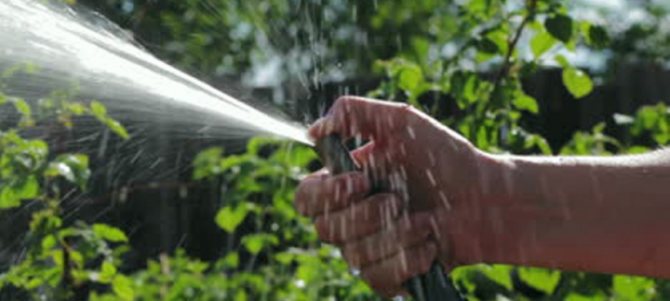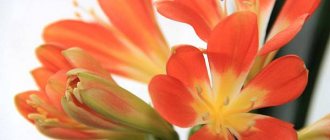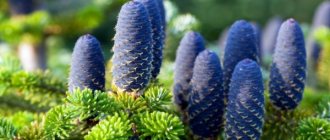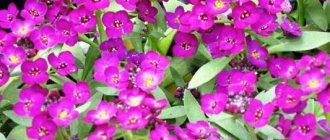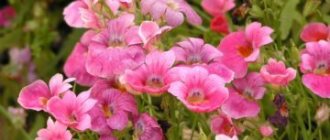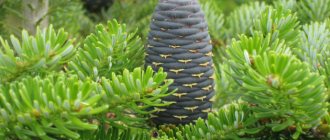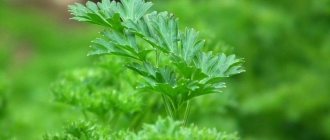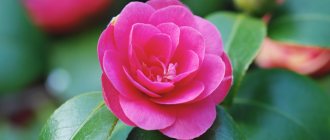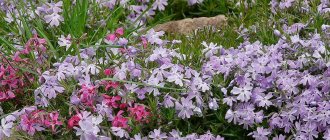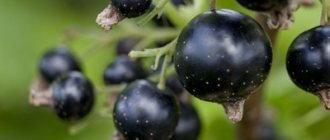A cute coniferous fir tree with cones growing vertically on its legs, similar to New Year's toys, is a real decoration of the site, especially on the eve of the winter holidays.
Cones ripen in the year of flowering of fir. And it comes once every 1-3 years (depending on the age of the plant and the species). In autumn or winter, the fruits open up, releasing seeds-nuts. You can collect them and try to grow new fir trees.
Is it possible to plant fir on the site
Fir belongs to the pine family and unites more than 80 species, which are both tall trees and small shrubs. This plant is quite often found in the wild. It can be found in coniferous and mixed forests, it can grow as separate trees among spruces and pines, and in small groups. Fir planting in the country is quite common. These trees feel good in many climatic zones, they are durable and unpretentious. The technology for growing fir on a personal plot is simple and does not require special knowledge.
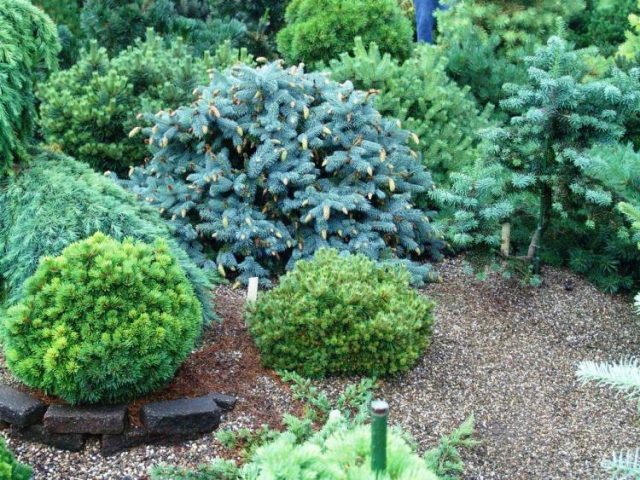
Important! The disadvantages of this tree include sensitivity to polluted atmosphere and dry air, as well as low frost resistance.
Plant care
Fir is not particularly whimsical, but you still need to take care of it, especially in the first years of life. Necessary measures:
- The first summer after planting in the country, the seedling is watered 2-3 times a month. After it is completely rooted, it should be moistened only in steadily hot weather. And so the fir has enough natural precipitation.


Adult conifers have enough natural rainfall, so they are not watered
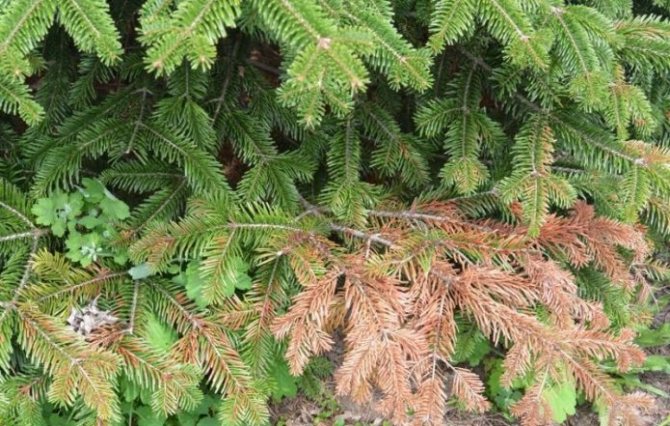

Fir does not really need artificial crown formation, but sanitary pruning is necessary
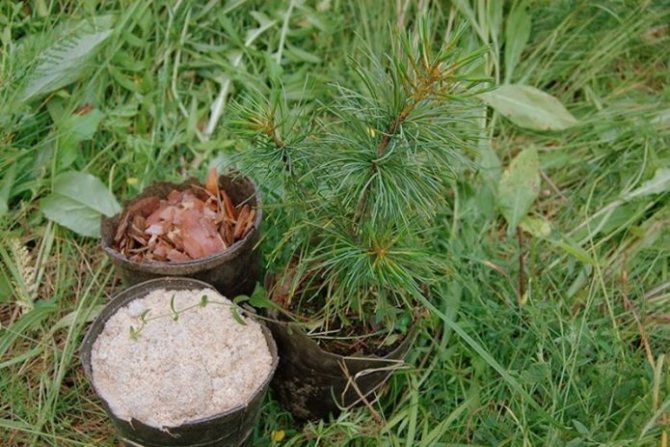

Fir seedlings can be fed with bark, ash and peat
Choosing a landing site
A plot with suitable conditions for a crop is the key to successful fir cultivation. The plant feels good next to a reservoir, while waterlogging of the soil, constant waterlogging should not be allowed. This perennial has a powerful root system that goes deep into the depths, therefore, the close passage of groundwater will lead to decay and death of the tree. You can plant a seedling in an orchard, on an alpine slide (decorative varieties), take it to the country. The main thing is to choose the right place so that you do not have to transplant.
Fir characteristic:
- shade-tolerant;
- winter hardy;
- hygrophilous;
- a young tree requires protection from strong winds and drafts;
- does not tolerate gas pollution and smoke from large cities;
- prefers drained, fertile soil.
On a note! The spring sun and dry air damage the shoots, but when favorable conditions are created, the damaged crown is restored.
Lighting for fir
The breed grows in the wild in shady forests, so it feels good in partial shade and shade conditions. When planting a single plant, it should be borne in mind that direct sunlight can provoke a burn of the needles. At the same time, an open area, where there is the possibility of a little shading of young seedlings, will allow the fir to develop well, promote rapid growth, and accelerate seed production. In the forest, seed material is formed after 60-70 years, with single plantings after 30 years.


The breed grows in the wild in shady forests, so it feels good in partial shade and shade conditions.
Planting and caring for Korean fir
With this tool, you can disinfect a wound, treat cuts and abrasions.
This procedure consists in keeping the seeds in a moist substrate.
Young seedlings must be loosened, keeping a distance of 25-30 cm. From time to time, it is important to mulch the ground with sawdust, peat near the trunk circles at a distance of 5-8 centimeters.
Peat
Crushed stone 20 centimeters deep or broken brick is poured into the dug hole.
Another dwarf species with bluish-green needles called "Kiwi" will undoubtedly become the main decorative element of the garden.
You can propagate Korean fir and annual cuttings, with the conditions that they will have a kidney on top. A more efficient way, but again not so simple. Germination is carried out without fail at a temperature of 18 to 23 degrees Celsius and with moderate watering.
Acid or neutral soil favorably affects the development of Korean fir. Before planting Korean fir, you need to make sure your tree will sit in a location where the soil is sufficiently moist.
Dmitry Kizulev, village Stanichki, Smolensk region
4 Care
Fir in landscape design
The tradition of planting fir trees in private plots has existed for a long time. In Soviet times, numerous plantings of these trees adorned the territories of sanatoriums, rest homes, scientific institutions, school yards. This is due not only to the decorative component. Fir emits a magnificent coniferous aroma, and its needles emit a large amount of phytoncides - volatile compounds that disinfect the air. These trees are planted both in single and in group plantings, using them as architectural elements, pillars or rows of columns when decorating alleys.
Transplanting a tree from one place to another
After transplantation, ephedra quickly adapt to a new place. If you want to change the location of a young plant, no special preparation is required. It is necessary to dig in the tree with a shovel, stepping back from the trunk 35–40 cm, and remove it together with the roots. Without shaking off the ground, the seedling is transported on a wheelbarrow to the planting pit and installed in it.
A different approach is required for an adult fir. You can transplant it like this: with a shovel, they poke the ground around the tree with a larger indentation than in the previous case. This is done a year before the planned procedure so that the root system has time to grow within the designated border. This will prevent root damage during transplantation. Then they take out the fir together with an earthen lump (it is more convenient to do this together), transport it and plant it in a new place.


A suitable tree is found in the forest, dug up and transported to a new planting site
Many gardeners choose to transplant fir from the forest. The best time for this action is early spring or the last days of summer. How to act in a similar situation:
- Choose the copy you like. It is recommended to stay on a tree no more than 1 m high.
- Examine the seedling for damage.
- Dig in the tree in a circle corresponding to the diameter of the crown.
- The tree is removed and the roots are wrapped with a damp cotton cut.
- The seedling is delivered to its destination.
- Before diving into the hole, the fabric is not removed, but only untied and straightened along the bottom.
- The tree is covered with forest soil and watered abundantly (at least 1 bucket under the root).
For the successful rooting of fir in the garden, it is recommended to take land from the forest and add it to the planting hole. It is also worth remembering the southern side of the trunk, so that you can then plant a tree on your site in the same direction.
What kind of fir to plant in the country in the suburbs
The climate of the Moscow region is quite suitable for fir planting. Severe frosts are now very rare, so the probability of tree death in winter is low. For landing in the suburbs, you can use the following types:
- Balsam fir. In natural conditions, it lives up to 300 years, while growing up to 15 m. There are dwarf varieties (Nano and Piccolo). The needles are up to 2.5 cm long, soft, even. Differs in a dense specific coniferous smell.
- Korean fir. An evergreen coniferous plant with a wide pyramidal crown. Reaches 15 m in height and 2.5 m in diameter. Needles up to 2 cm, dull, saturated bright green color. It has quite a few varieties (Silberlock, Molly, Tundra, Oberon, Green Carpet, etc.), is widely used in ornamental gardening.
- Siberian fir. Under natural conditions, it lives up to 200 years, while reaching a height of 50-60, and in some cases 100 m, the trunk diameter can reach 2.5 m. The crown is conical, narrow. The needles are up to 3 cm long, soft, with blunt tips. Has a delicate pine aroma.
- The fir is great. In the wild, it is found in North America. The tree grows up to 35-50 m, sometimes up to 70 m, the trunk diameter is up to 1.5 m. The crown is pyramidal, in an adult tree it becomes round. The needles are soft, up to 5.5 cm long, bright green with a white stripe below. Lives up to 200-250 years.
- Whole-leaved fir. It grows up to 30 m by the age of 100, and at a more mature age - up to 55 m. The crown is wide, conical. The needles are up to 4 cm long, light green, flat.
Growing and caring for fir in the gardens of the Moscow region is no more difficult than in other regions. The above species have long and successfully grown not only in this area, but also much farther north.
Phased fir planting
Having chosen a site, you should prepare it in advance. It is advisable to start this week 2-3 weeks before planting. The area should be weeded out, cleaned of biological debris (fallen leaves, branches, etc.). Next, you should start forming the landing pits. On average, each hole should be about 80 cm deep and 50–70 cm wide, but these figures can be adjusted depending on the size of the seedling rhizome together with the earthy clod.
Important! Fir over time oxidizes the soil composition, saturates it with resins, so you cannot plant them next to fruit trees, the yield of which will greatly decrease from such a neighborhood.
When making a hedge made of fir trees, the interval between trees should be about 3-4 m, but if it is supposed to form a group flower bed composition, you can keep a distance of 2.5 m.After digging the planting holes, they are supplied with a drainage layer and half covered with nutritious soil mixture, which was mentioned earlier, sawdust and fertilizer are added.
Now you need to wait a couple of weeks, after which you can start planting young trees, observing the following procedure:
- Form a small hill from the nutrient soil with which the hole is half filled.
- Carefully remove the seedling from the pot, place it vertically on a hill, straighten the roots along the edges. Try to immediately position it correctly, at such a height that after planting the root collar is at ground level, if necessary, you can add a little soil under the seedling or, conversely, partially remove it.
- Fill the planting with prepared soil mixture to the top, tamp it lightly.
- Water abundantly, spending at least 10 liters of water for each tree. If you notice that moisture is quickly absorbed into the soil, watering can be repeated again.
- Cover the trunk circle with a layer of mulching material such as peat, sawdust or tree bark to retain moisture in the soil and protect young roots.
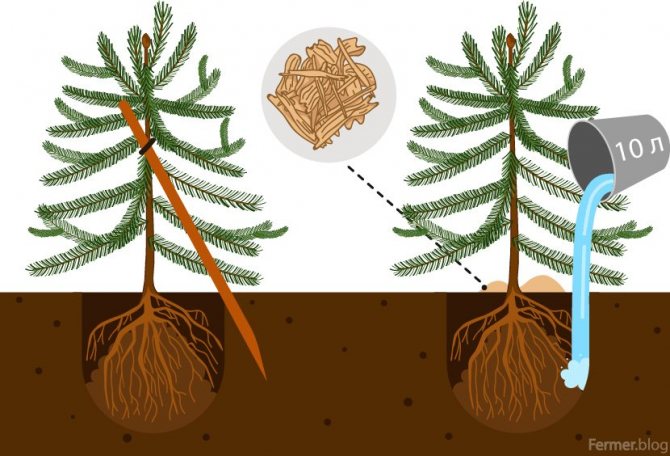

To improve root growth, it is recommended to use a rooting agent immediately after planting.For example, a 0.002% Heteroauxin solution will be a good remedy for fir. 5 liters are consumed per seedling. It can also be applied to mature trees that have experienced stressful situations.
Video: planting fir
Fir: description of a coniferous plant
The homeland of this evergreen plant is the Caucasus and North America. The variety of tree varieties has made it a favorite of many gardeners. If the fir grows in the wild, then its height can reach eight meters, the growth of decorative species rarely exceeds two meters.


The trunk of a fir is covered with a hard bark with small cracks or even smooth (it depends on the variety), the root is taproot, but very powerful, which allows it to go to a sufficient depth. The needles of this tree are flat, soft, located spirally on the shoot (in some varieties - comb).
What is interesting in fir for our gardeners and summer residents
Fir is an evergreen coniferous tree from the Pine family. It can be from 50 cm to 70 m in height, depending on the species. Only in nature can you find gigantic trees. And mainly medium-sized specimens are cultivated. The tree has a superficial root system. At a young age, the trunk is covered with a yellowish-gray smooth bark, but over the years it coarsens and forms seals that contain resin.
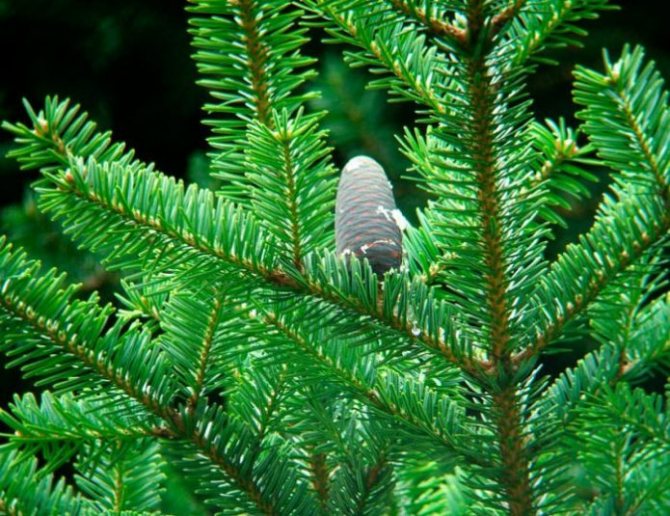

Fir has soft needles and standing cones of a bluish-purple hue
The crown of the ephedra is conical, and its base practically touches the ground. Unlike other representatives of this family, fir needles are soft and do not prick. Another individual feature is the horizontal arrangement of the branches. On them, egg-shaped cones with female and male spikelets grow vertically upwards. The first flowering and fruiting in fir occurs after 25 years. And on average, she can live up to 200 years.
How to plant a fir on the site
Planting a fir is no more difficult than any other tree. For planting, seedlings are used that have reached the age of 4 years. They can be purchased at specialty stores or nurseries. Photos of fir seedlings below:
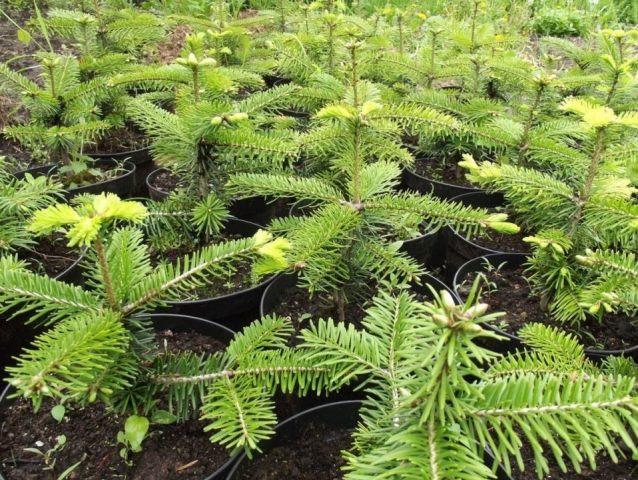

Landing dates
The best time to plant fir in a permanent place in the garden is April. If the deadline is missed, do not rush. Fir can also be planted in late August or early September. Fir planting technology in the fall does not differ from the spring one. However, later dates are undesirable, since the seedlings may not have time to acclimatize in a new place and will die from frost. Fir planting in winter in open ground is possible only in the southern regions, where there are no freezing temperatures.
Where to plant fir on the site
Shady or semi-shady areas are suitable for planting fir. The soil is preferable loamy, loose and fertile, moderately moist. It is recommended to plant these trees at a short distance from natural bodies of water. Fir can be planted near the house, however, it is also necessary to take into account the dimensions of the future tree, as well as the fact that it will give significant shade.
Landing site preparation
To plant the fir correctly, holes for future trees must be prepared in advance, preferably 2-4 weeks before the expected landing date. Their value depends on the size of the container in which the seedling grows, since the planting is carried out together with a lump of earth on the roots. Usually a hole 0.6 m in diameter and the same depth is quite enough. Drainage from large rubble, expanded clay or broken brick should be laid at the bottom. Then the hole is filled up to half with a soil mixture consisting of river sand, peat, humus and sod land, taken in a ratio of 1: 1: 2: 2. Additionally, you can acidify the soil with clay or sawdust.
Important! 0.2-0.3 kg of nitroammofoska can be added to the soil mixture.
Site preparation
It is very important to choose the right place where to plant fir in the garden.Unlike many ornamental crops, the coniferous plant prefers partial shade rather than open sunny areas of the garden. Strongly darkened and thickened areas should not be chosen, because such conditions will provoke the development of fungal diseases and pest attacks. In addition, trees do not develop well in the shade, and the crown loses its decorative effect.
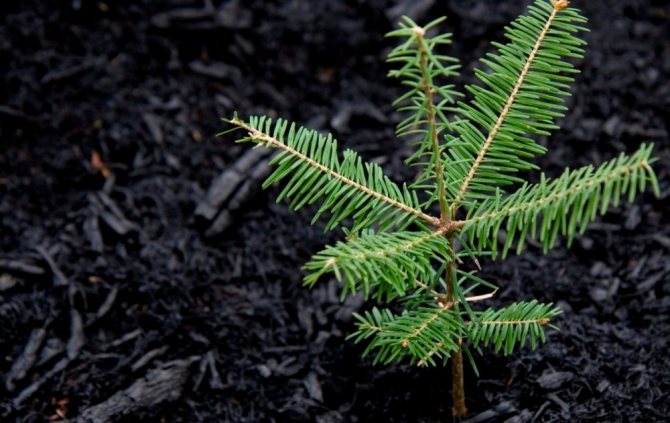

If you plant several trees at once, you need to observe a certain distance, since horizontally growing branches of plants will interfere with each other over time, and the roots, in fact, too. When preparing, immediately decide on the design of the site, draw a diagram of where the fir will be located, whether it will be a single planting, a group composition with other conifers or flowering plants, or a hedge. Choose the right neighbors correctly. It is best to draw a diagram - this way it will be easier to navigate where to dig planting holes for trees, because between them you will need to maintain a certain distance.
Conifers are not afraid of strong gusts of wind, so they feel great in single plantings in open areas. Extremely waterlogged soil can cause serious damage. It is desirable that there are no wetlands on the landing site. If the underground groundwater runs too high to the soil surface, when planting, it is necessary to lay a drainage layer of crushed stone or broken brick on the bottom of the pit.
Learn how to care for the Diamond Fir.
In a wild forest, fir grows on any soil. However, when planting a tree near a private house, each owner first of all seeks to achieve a decorative landscape picture, where the plant will delight the eye with its lush healthy needles, so it is desirable to form the most optimal soil composition for fir.
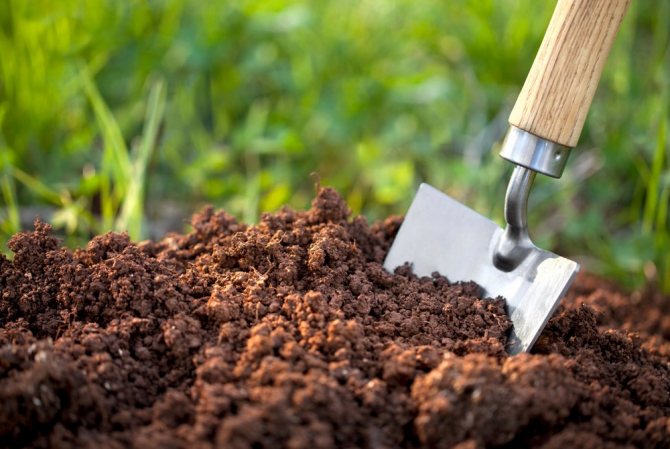

For this, a mixture is prepared separately: take 3 parts of clay and humus and 1 part of sand and peat, mix. In addition, when planting, 6–8 kg of sawdust and 200 g of Nitrofoski, a mineral fertilizer, should be added to each hole, which will provide young seedlings with all the necessary nutrients for successful rooting and development in the first years.
Features of planting a tree at home
A tree in a container will look very impressive, but breeding it will require adherence to some rules. And to make it easier to care for the tree, it is advisable to use a stand for a container on wheels, with its help it will be easier to move an adult tree around the room.
Illumination, humidity and temperature conditions
If the plant was purchased in winter, then before planting it in a permanent container, it must be given time to get used to the new conditions. At the beginning, the conditions should not differ from the store conditions, that is, the temperature should be lower than in the room. As soon as the seedling gets used to the situation, it should be placed in the place where it will stand in the future. A good pallet and drainage should be prepared in advance, because the plant loves moist soil, but does not tolerate the accumulation of water, since under these conditions its roots will rot. Any air is suitable for good plant growth. There is absolutely no need to organize any measures that will relate to the humidification of the tree's habitat.
How to choose a container for disembarkation
The acquired tree can be immediately planted in a large container with a displacement of 10 liters with optimal soil, so as not to destroy a clod of earth near the rhizome. It is preferable to grow a plant in a large container, since they are more resistant and can accommodate more soil, while the soil in them will remain moist for more time. But dwarf fir must be dived into large containers every 3 years. The most suitable period for a dive is September-October.In order for the plant to take root in a new container, it is not necessary to clean the soil from the roots, and the soil after transplantation must be fed with drugs.
Preparation of soil for planting
The main thing to worry about is the correct choice of soil. The soil should be nutritious and neutral, it is possible to use slightly alkaline. In the natural environment, the cultivation of the plant is carried out with seeds, so it is more desirable to choose light soils, loams, a ready-made composition for conifers or a special composition consisting of clay, peat, sand and leafy soil as a basis. And in order to maintain good nutrition during planting, complex feeding should be made. In this case, it is necessary to make sure that the root collar of the plant is kept at ground level.
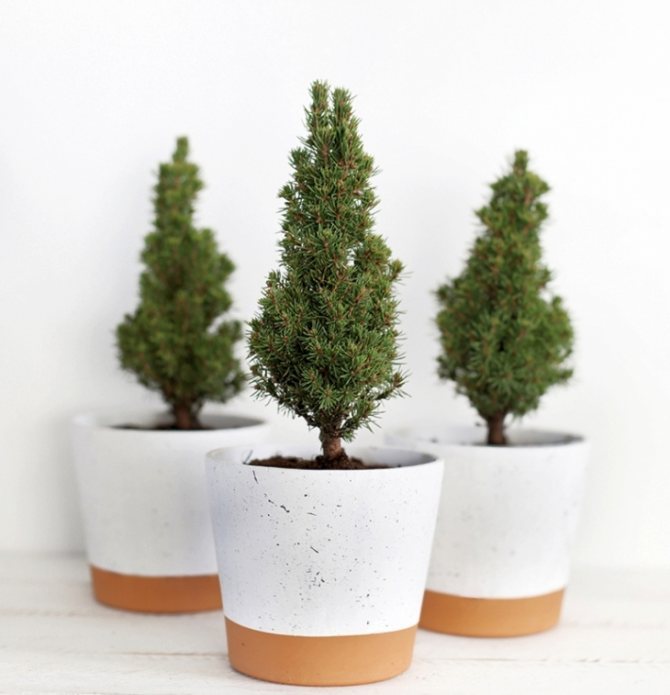

Watering and feeding
The plant loves moist and loose soil.
The most popular among gardeners is the dwarf fir variety. Such a plant has a bizarre flat-round shape. The bright emerald color of the plant with gentle open branches is an excellent decoration for any garden area.
Young plants are advised to feed in the process of caring for Korean fir, and fertilization is not required for adults.
Simultaneously with the planting of Korean fir, agronomists advise to mulch the area near the trunk with sawdust or peat. In this case, the height of the mulch layer should be at least 5-8 cm. This is useful so that the young plant does not suffer from severe frosts. In adult plants, frost resistance is higher, therefore, it is not necessary to cover the peri-stem region. It is also recommended to pre-make drainage from bricks or rubble.
Fir trees are quite undemanding, but they prefer rich, moist and well-drained soil. They do not like excessive dryness of both air and soil. It is necessary to water at least the first 5-10 years regularly enough, then the plant will form a powerful deep root and will be able to extract a sufficient amount of moisture by itself. The first 2-3 years need to be fed with a special fertilizer for conifers, then - at will. The fact is that the fir accumulates a layer of coniferous litter under the crown, which serves as both fertilizing and mulch. It is not necessary to remove it! Fir is quite winter-hardy, but it is still advisable to cover young plants with spruce branches so that they are not damaged by recurrent spring frosts.
- Cones ripen in the year of flowering of fir. And it comes once every 1-3 years (depending on the age of the plant and the species). In autumn or winter, the fruits open up, releasing seeds-nuts. You can collect them and try to grow new fir trees.
How to care for a fir
Fir care is not particularly difficult. The tree is quite unpretentious and, as a rule, does not cause trouble for the gardener. The only exceptions are decorative species, which must be constantly looked after.
How to water a fir
Fir does not require watering. For most species of this tree, artificial irrigation is not only not required, but also contraindicated, since excess moisture has an extremely negative effect on it. The only exception is moisture-loving species, such as, for example, balsam fir, which should be moderately watered several times during the summer and only during prolonged drought. For the rest of the species, precipitation is sufficient.
How to feed
Planting nutrients are usually sufficient for the first few years of the fir's life. Further feeding is done once a year, in spring. 0.1-0.15 g of complex fertilizer Kemira-Universal is usually applied to the tree trunk circle, combining this procedure with cleaning and loosening the soil.
Loosening and mulching
Caring for the root zone of the fir after planting is one of the mandatory procedures that must be carried out constantly. It is very important to keep the tree trunks clean, this significantly reduces the likelihood of diseases and pests on the plants.Loosening should be carried out after each rain or watering, while removing weeds. Peat, humus, tree bark or wood chips can be used as mulch, laying it out in a layer of 8-10 cm.
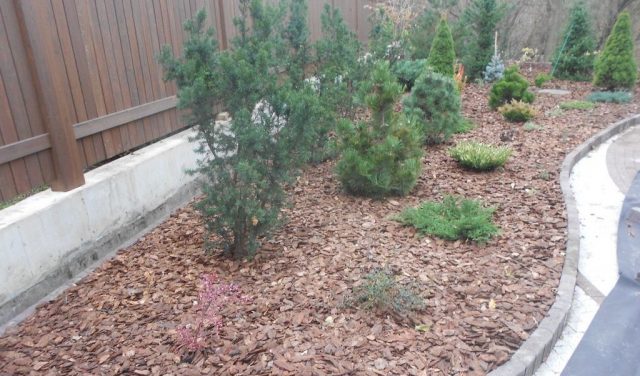

Trunk circles are usually mulched within a radius of 0.5 m around the tree trunk, without closing the root collar.
Fir pruning
Most of the fir species have a neat, beautiful appearance and without any interference. An exception can only be decorative species, which must be maintained in the given dimensions of the crown. Pruning of these trees can be done in early spring, before the start of the growing season. In addition to such pruning, sanitary cleaning is carried out in the spring, during which branches that are broken, dried up and frozen over the winter are removed.
Preparing for winter
Mature trees withstand the winter cold quite well without any preparation. It is advisable to cover young plants for the winter. It is best to use spruce branches for this or build a special shelter in the form of a frame made of slats covered with burlap. The inner space of such a shelter is filled with straw, fallen leaves or wood shavings. This method is guaranteed to protect newly planted young trees not only from winter frosts, but also from damage to the crown by the bright spring sun.
Care after landing
Growing fir is considered easy because the plant does not require much maintenance. The first 2-3 years it needs to be watered, protected from frost, and tied up. An adult tree should be fed once a year. The culture gives a small annual growth, so you should not worry that there are not enough nutrients.
Fir care involves preventive measures against uninvited guests. If favorable conditions are created for the plant, then the risk of infection with infections or damage by pests is very small. Improper planting, lack of drainage in heavy soil, waterlogging or drying out of the soil lead to the development of fusarium, brown shute, rust. Creation of an optimal growing environment, removal of damaged branches, treatment with biological products will help save the fir.


Improper planting and care leads to the development of plant diseases.
Of the pests, aphids, spruce false shield, spider mites, fir and pine moths, leaf rollers, pine cones, wireworms, bark beetles are dangerous. To eliminate them, they use spraying with insecticides and biological products, catching adults with the help of traps, sideration, processing with compositions according to folk recipes.
The advantage of planting in spring is that the plant has time to adapt to new growing conditions by winter, and is less prone to freezing. The culture is hardy, but young seedlings need additional protection. The near-trunk circle must be mulched with peat, needles, straw, sawdust, the tree itself must be covered with spruce branches. It is not recommended to use oilcloth, because without air access, the branches will become moldy and start to rot.
On a note! The mulch should not cover the root collar.
Watering
At first it is recommended to moisten the fir once a week. An adult rooted plant requires additional watering only in dry weather. For a tree growing in an open area, the procedure is needed more often, since direct sunlight quickly dries up the earth, and this is destructive for this breed. In the fall, before a strong cold snap, it is recommended to carry out water-charging irrigation of spruce plantings. A burn of needles from the bright spring sun often occurs due to a lack of moisture, the plant is not able to withstand an unfavorable factor. In the absence of mulch, it is necessary to loosen the soil to a depth of 10-15 cm after each watering. The procedure should be performed carefully, some varieties of coniferous crops develop a superficial root system.
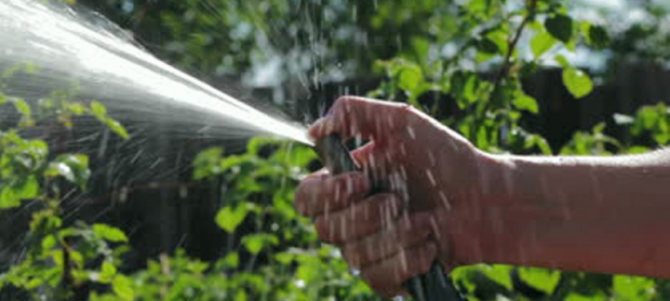

A tree growing in an open area needs watering more often, since direct sunlight quickly dries up the soil.
On a note! Young seedlings love sprinkling irrigation.
Top dressing
It is carried out 2-3 years after planting. The optimal time is spring (late April - early May). Use universal complex additives as fertilizer. In autumn, under the digging, add granular superphosphate, potassium salt. From organic matter, it is recommended to use vermicompost, rotted compost. In the spring, it is advisable to use liquid fertilizers that reach the root system faster. Water them in a near-trunk circle, and not at the root.
Soil care
The culture requires loosening, weed removal. If necessary, transplant fir, since the plant will not take root under constant exposure to unfavorable factors. In some cases, instead of fertilizing and transferring to a new place, it is recommended to remove the surface layer of the earth by 10-15 cm and replace it with a fertile soil mixture with soil from under the spruce species.
Pruning and shaping the crown
These procedures are optional, since the culture does not need them. Fir pruning is carried out at any time of the year except winter in order to remove damaged shoots - burnt, infected with pests or diseases, dried, frozen. Of the 2 intersecting shoots, the strongest remains or growing in the desired direction. The plant regenerates slowly, unlike fruit trees, so you need to remove the branches carefully, if indicated.
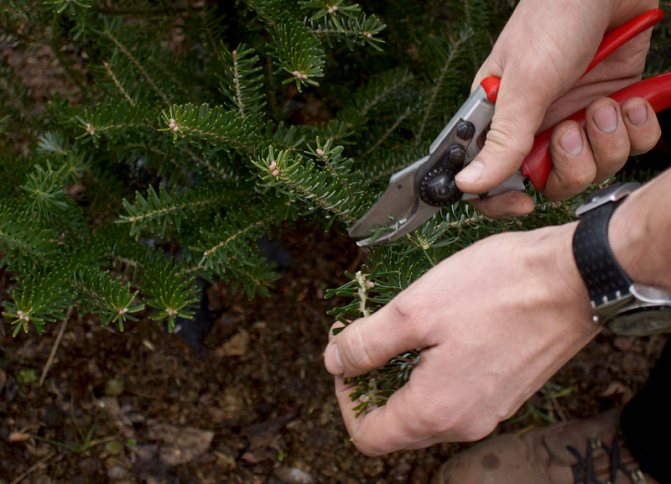

Fir pruning is carried out at any time of the year except winter in order to remove damaged shoots.
The breed is characterized by decorativeness, the formation of the crown is carried out only if the gardener wishes to give the fir a bizarre shape or to cut an overgrown plant. The procedure should be postponed until dormant - late winter or early autumn. In varieties with rope-like sharp needles, the incision should be made 1 cm above the kidney. The topmost bud will become the new top and sprout. This pruning stimulates the growth of needles below the buds. In varieties with flat needles, the shearing needs to slightly restrict external growth in order to increase the splendor of the crown.
Types and varieties of fir with photos and names
There are a fairly large number of species and varieties of fir, but not all of them are popular with gardeners. Below will be described those of them that are more or less in demand in culture.
Balsam fir (Abies balsamea)


Under natural conditions, such a fir can be found in the United States and Canada, while its habitat in the north is limited to the tundra. In mountainous areas, such a tree can be seen growing at an altitude of 1.5-2 thousand meters. This frost-resistant shade-loving plant does not live very long, only about two hundred years. The height of such a plant can vary from 15 to 25 meters, and its trunk reaches 0.5–0.7 meters in thickness. Young fir trees are covered with gray-ash smooth bark. Older trees have cracked reddish-brown bark. Resinous pale green buds are light purple in color and are spherical or ovoid in shape. In length, dark green glossy needles can reach 1.5-3 centimeters, stomatal lines run along their entire surface. The needles can be slightly notched at the tops or blunt, they die off after 4–7 years. If you grind them, then you can feel a pleasant aroma. The height of the oval-cylindrical cones can vary from 5 to 10 centimeters, and their width is 2–2.5 centimeters. Unripe buds are dark purple in color, which after ripening changes to brown. Mature buds are highly resinous. This species has been cultivated since 1697. This fir is planted singly or used in small group plantings. The most popular forms are:


- Hudsonia... This mountain dwarf plant has very dense branches, a wide crown and many short stems.Short needles are wide and flat in shape, their front surface is green-black, and the back is bluish-green. Cultivated since 1810
- Nana... The height of the tree does not exceed half a meter, the diameter of the rounded crown is about 250 centimeters. Thick, spreading branches are arranged horizontally. The short, lush needles are colored dark green, while on its lower greenish-yellow surface there are 2 stripes of bluish-white color. It has been cultivated since 1850. This plant is perfect for landscaping roofs, terraces and rocky gardens.
The following forms of this type are also cultivated: gray fir, variegated, dwarf, silvery, columnar, and even prostrate.
Korean fir (Abies koreana)


In nature, this kind can be found in the mountains of the southern part of the Korean Peninsula at an altitude of 1.8 thousand meters. These firs create clean forests and mixed ones. Young fir trees are very slow growing. However, in older specimens, the growth rate becomes faster over the years. In height, such a tree can reach 15 meters, while the trunk diameter varies from 0.5 to 0.8 meters. The shape of the crown is conical. Young specimens are covered with smooth ash-colored bark, in some cases with a purple tint. Older specimens have chestnut bark with deep cracks. The practically round buds are only slightly resinous. Lush needles are tough enough. Each needle is curved with a saber and has a notch at its apex. The upper surface of the needles has a dark green color, and the lower one is silver (due to 2 very wide stomatal stripes). The length of the cylindrical cones is about 5-7 centimeters, and in diameter they can reach 3 centimeters. Young buds are colored lilac-purple. This plant was brought to European countries only in 1905. This species is distinguished by a very high decorative effect due to its two-color needles, as well as winter hardiness. This article describes the planting and care of this particular type of fir. Varieties:


- Blue Standard... It differs from the original species only in the dark purple color of the cones.
- Brevifolia... This cultivar is characterized by extremely slow growth and a dense rounded crown. The needles are not so dense in comparison with the original species, its upper surface is painted in a swamp-green color, and the lower one is grayish-white. The color of small cones is purple.
- Piccolo... A tree in height can reach only 0.3 m. In an adult specimen, the diameter of a spreading horizontal crown can reach up to 50 centimeters. The needles are the same as in the main species.
Caucasian fir, or Nordmann fir (Abies nordmanniana)


This species is considered a Caucasian endemic, because in nature it can be found only in the Caucasus Mountains. In height, this plant can reach 60 meters, and the trunk has a thickness of about 200 centimeters. Low-set branchy lush crown has a narrow conical shape. The crown apex is sharp, but in fairly mature specimens it is not very pronounced. The trees are covered with glossy smooth bark, but deep cracks form after the plant is 80 years old. Egg-shaped buds have practically no resin. The length of the needles is about 4 centimeters, and its width is about 0.25 centimeters, its upper surface is painted in dark green, and on the bottom there are 2 stripes of white color. On cone-bearing shoots, the tops of the needles are gently pointed, and on vegetative ones, there is a notch at the tops. In length, the cones reach 20 centimeters, and in diameter - 5 centimeters. Young buds are green while old buds are resinous dark brown. This species is fast-growing, and such a plant can live for about 500 years. The forms of the Caucasian fir: weeping, golden-pointed, gray-gray, erect, golden and white-pointed.
White fir (Abies concolor)
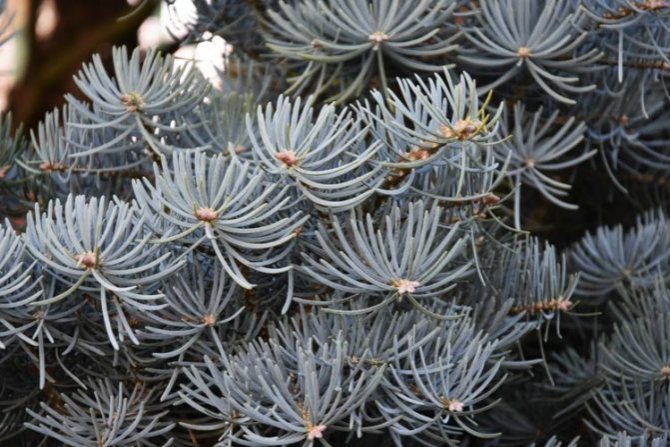

Such a fir is considered the queen among the representatives of the genus of fir. Under natural conditions, it can be found in the Southwest of the United States and in the North of Mexico. This tree prefers to grow in river canyons, as well as on mountain slopes at an altitude of 2 to 3 thousand meters above sea level. This species has a very high drought tolerance, while such a tree can live for about 350 years. Its height can vary from 40 to 60 meters, and the trunk thickness reaches 200 centimeters. The cone-shaped crown of a young tree is very lush, but as it ages, it thinns significantly. The color of the bark on older specimens is ash gray, while it is very coarse and cracked. The green-yellow resinous buds are spherical and about 50 mm in diameter. The length of the green-gray needles can be up to 7 centimeters, and its width is up to 0.3 centimeters. The apex of the needles is rounded and notched, while the stomatal lines are located on both their upper and lower surfaces. The shape of the cones is cylindrical-oval, they can be up to 14 centimeters long and 5 centimeters wide. The color of unripe cones is green or purple, and the color of mature ones is pale brown. It has been cultivated since 1831. This plant looks incredibly beautiful against the background of yellowed larches in autumn. Popular decorative forms:


- Fir Compact... A dwarf shrub cultivar with open branches and blue needles. In some cases it is referred to as the Glauck Compact.
- Violacea... The height of such a fast-growing plant can reach up to 8 meters. The wide crown has a conical shape, and the long needles are bluish-white. This fir has a very high decorative effect and is also resistant to drought.
Siberian fir (Abies sibirica)
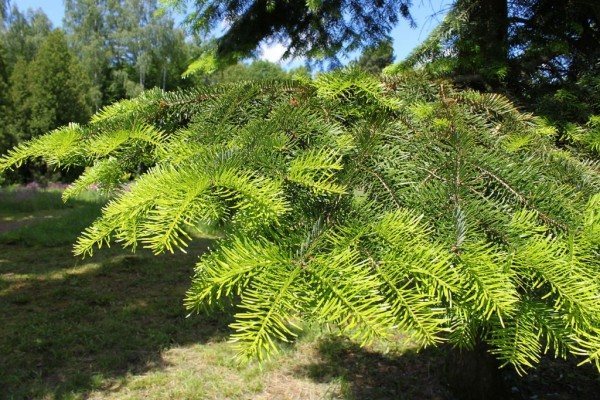

Under natural conditions, it can be found in the north-east of Russia, while this tree prefers to grow in river valleys, as well as in the highlands. This species is distinguished by winter hardiness and shade-loving, and it is under state protection. Siberian fir is the most famous species of all that are included in this genus. In height, the plant can reach no more than 30 meters, and its narrow crown has a conical shape. The gray bark is smooth almost along its entire length, but at the very bottom it cracks. Narrow glossy needles are very soft, and they reach 30 mm in length. Their upper surface is dark green, and on the lower one there are 2 stripes of white color. Ripe upright buds become pale brown. Varieties of Siberian fir: white, graceful, blue, variegated, etc.
Not only the species described above are cultivated, but also such firs as: subalpine, Frazera, whole-leaved, equally scaled, Semyonova, Sakhalin, mayra, graceful, cephallian or Greek, tall, Vicha, white-brown or bud-scaled, white or European and Arizona.
Pests and diseases
Ephedra have strong immunity, but they also tend to periodically get sick and be affected by pests. So, due to excessive watering and in the absence of drainage, fir is often exposed to a fungal disease - rust. It manifests itself as brown spots on the needles, swelling on the trunk and reddening of the branches. In such a situation, the affected shoots are cut off and burned along with the needles outside the garden plot. Then the sections are treated with garden pitch, and the crown is sprayed with a 1% solution of copper sulfate or Bordeaux liquid (200 ml per 10 l of water).
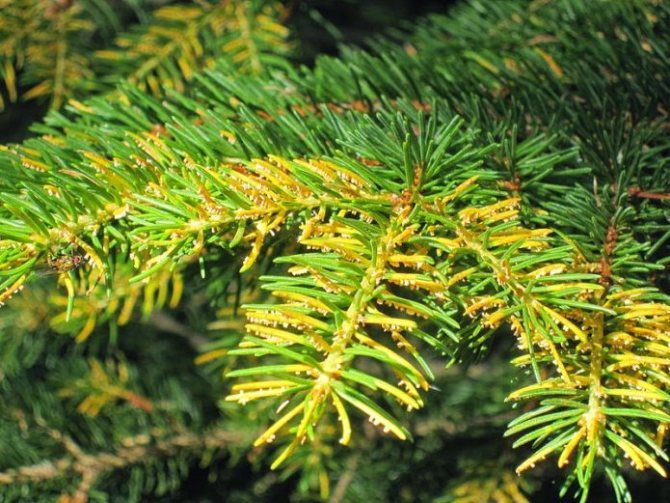

When a fir fungus is affected by a fungus, the needles turn yellow and become covered with white balls
To avoid re-infestation of the plants, the nearby carrier grasses - chickweed and starworm (if present) are removed.
Of the pests that often annoy the fir, there are:
- Hermes;
- bark aphids;
- pine cone roll;
- shoot moth.
To get rid of them will help pesticides or preparations "Antio" and "Rogor" (dissolve 20-25 g of the product in 10 liters of water).Trees are processed in early spring.
Fir propagation
You can grow a fir yourself from seeds or by propagating it by cuttings. This is a rather lengthy process, so a gardener who decides to take such a step should be patient for several years in advance.
How to grow fir from seeds
Growing fir from seeds at home is a rather long and laborious process. Difficulties arise already at the stage of harvesting seeds, since ripe cones are located on the top of the tree. In addition, fir seeds are light and volatile, they quickly spill out and are carried by the wind. Therefore, they are procured as follows. Unripe cones with closed scales are plucked from the tree and placed in heat. After the cones ripen and open, seeds are poured out of them.
Important! You can collect planting material by tying the selected cones with gauze bags in advance.
After collecting a sufficient number of seeds, they are subjected to stratification. It can be carried out both at home, by placing the planting material in the refrigerator, or on the street, simply by burying a container with seeds in the snow. They need to stay in such conditions for about 120 days. Stratified fir seeds are planted in April in special containers filled with a mixture of sand, peat and turf. Planting depth should not exceed 1-2 cm. Containers are covered with plastic wrap, simulating greenhouse conditions.
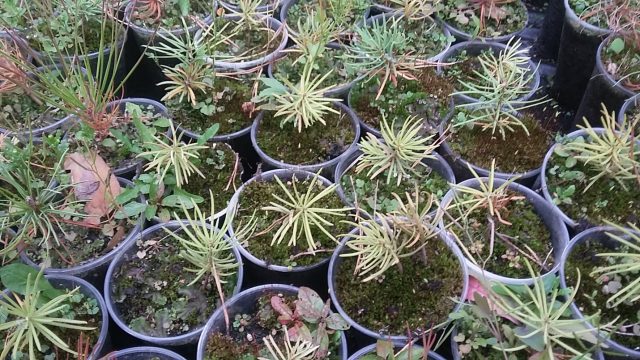

Periodically, the containers are ventilated, and the soil is moistened and gently loosened. The first shoots should appear in 3-4 weeks. A year later, they are dived into separate containers and kept growing until the age of 4 years. Only after that young fir trees are planted in the spring in permanent places.
Important! Seedlings are characterized by rather slow growth, so you should not be surprised that fir in 4 years will only grow by 0.3-0.4 m. After planting, its growth will noticeably accelerate, and will be about 0.4 m per year.
How to propagate by cuttings
Fir can also be propagated vegetatively. Annual shoots 5-8 cm long with one apical bud are used as cuttings. Often they are not cut, but plucked, while a heel remains on the handle - part of an old lignified shoot. Cuttings are harvested in the spring using shoots growing on the north side of the tree in the middle of it. It is advisable to do this in cloudy weather. Prepared cuttings are disinfected before planting, keeping for 5-6 hours in a weak solution of potassium permanganate. Then they are planted in containers with nutrient soil, consisting of humus, sand and turf soil, taken in equal proportions.
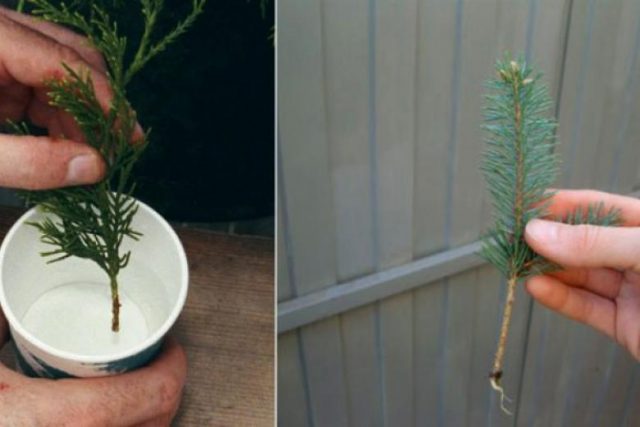

The planted cuttings are placed under film or glass. It is necessary to regularly ventilate them, as well as moisten the soil substrate. Rooting of fir cuttings is a rather lengthy process. It takes about a year for the cutting to develop its own roots. A full-fledged root system will be formed only for 2 years.
Some of the nuances of the breeding of fir - in the video:
Landing scheme
It is advisable to plant each seed immediately in an individual container. If a common container is used, young seedlings will have to be replanted later. Deepen 2-3 cm into a moist nutrient substrate, moisten the surface with a spray bottle, cover on top with glass or a transparent bag. Root the cuttings in pots filled with layers - drainage, turf soil, sand. In both cases, it is required to create greenhouse conditions until the seeds give the first shoots, and the cuttings release young leaves. Transplant the grown firs into small containers slightly larger than the formed root system. It is not recommended to take large containers, as this will slow down the growth of the tree.
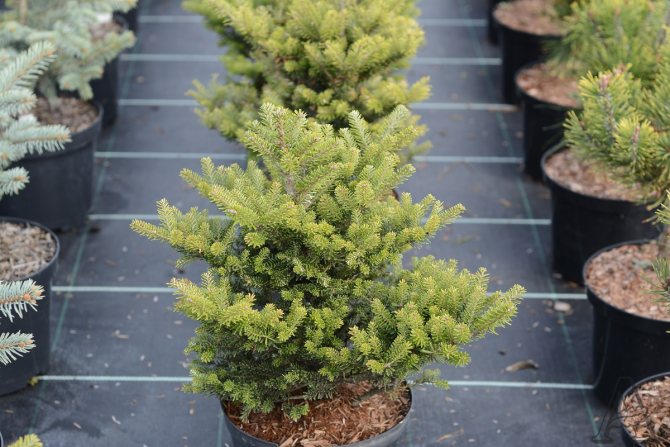

It is advisable to plant each seed immediately in an individual container.
Is it possible to bring out a tree in a flowerpot
For breeding a plant in a flowerpot, dwarf forms are perfect, which can now be purchased by everyone. When buying a tree, you should definitely take into account its frost resistance. If the fir in the container will stand on the balcony or in the garden for a long time, then its cold resistance should be about 2 zones higher than in the area. Important! Fir in a container will freeze faster than in open soil. The best solution for planting fir is to choose seeds. Therefore, they need to be prepared at the beginning of the ripening of the buds. It is possible to sow them both in spring and in autumn. And as soon as the sprouts sprout, they can be transplanted into individual containers. A dwarf plant may also be bred vegetatively, using cuttings with an apical bud, but this sapling will grow for a long time, and take root only after about 10 years.
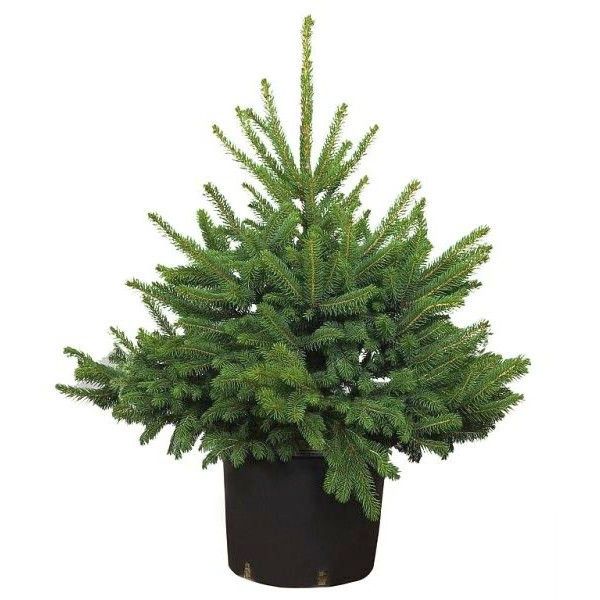

Preparing fir for planting
In order to grow a healthy tree, it is important to start with a competent approach to the process. This means preparing planting material and soil, choosing the right planting site with optimal conditions for growth.
Selection of seedlings
It is recommended to buy seedlings in nurseries or special points of sale. It is better to consult a specialist on site regarding the acceptability of a particular variety. Here, the climatic features of the region where the plant will be grown are taken into account. It is preferable to choose frost-resistant types of fir (for example, Siberian, balsamic or subalpine). You should not buy rare decorative forms that are thermophilic. There is a high probability of their death in the first year after landing.
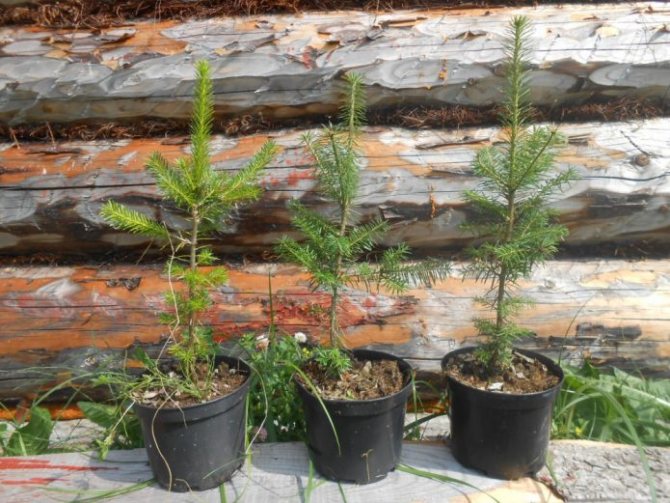

It is recommended to buy fir seedlings in containers, as they root better outdoors.
When choosing seedlings, they pay attention to their appearance. Any damage, signs of disease and dry branches are unacceptable. It is more rational to buy copies of 4–5 years old. The soil in containers must be clean and moderately moist.
Location
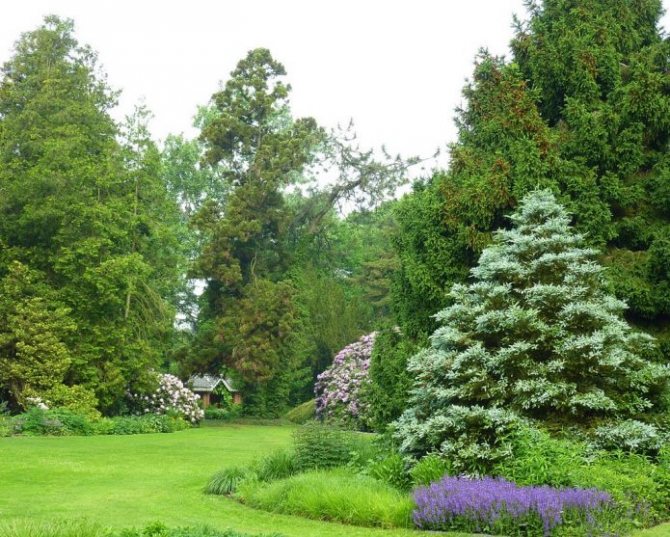

Fir will transform any site if you find the right place for it
Ideally place the fir in partial shade, which is especially important in the first years of life... The tree will not die from exposure to direct sunlight, but it will grow weak. Fir does not tolerate drought - it begins to wither and lose the attractiveness of the crown. But a strong wind is not terrible for this ephedra, so a single landing is possible. As for frost resistance, it differs by varieties. But all young trees suffer from recurrent night frosts, which are not uncommon in central Russia.
Firs love clean air, gas pollution and dust can destroy them. Therefore, suburban estates are an ideal place for growing conifers.
Fir severely depletes the soil as it grows. Because of this, there should not be any fruitful crops near the tree, which, from such a neighborhood, will experience a lack of macro- and micronutrients. Falling needles oxidize the soil, which is contraindicated in many plants. And also take into account the height of the tree in perspective. So there should be no wires over the site. You cannot plant an ephedra close to buildings - it is optimal to indent at least 15 m.
The soil
For all firs, fertile and loose soil, moderately moist, is preferable. If the soil is heavy and clayey during planting, it will be necessary to lay drainage in the form of rubble or broken brick.


If the soil is clay, then drainage is poured at the bottom of the planting pit
Optimal soil mixture for fir:
- leaf compost - 3 parts;
- peat (humus) - 1 part;
- river sand - 1 part;
- clay - 2 parts.
Diseases and pests
Subject to all the rules for caring for fir, diseases and pests appear on it quite rarely. Problems are possible only under adverse weather conditions, as well as violation of planting rules or poor ecology.The most common diseases affecting these trees are as follows.
- Brown fir shute. A fungal disease manifests itself in the yellowing of the needles, which subsequently turns black. The needles stick together, but do not crumble for a long time. In autumn, rounded black fruiting bodies of the fungus are clearly visible on them. As a preventive measure, it is recommended to avoid thickening of the plantings and waterlogging, you should also pay attention to the quality of the planting material. When a disease appears, it is necessary to cull, and treat neighboring plantings with biological products or fungicides.
- Fusarium. Caused by soil fungi. It occurs with excessive moisture and tree planting on heavy, poorly drained and clayey soils. The disease begins with damage to the roots and then penetrates into all tissues of the tree, which gradually turns yellow from below. When a disease occurs, the infected tree is destroyed, and the soil and neighboring plantings are treated with fungicides.
- Rust. Fungal disease, which especially often affects the planting of young plants. It manifests itself in the summer in the form of a yellow or orange bloom on the branches, strongly weakens the trees. To prevent the appearance, young plantings should be treated with copper sulfate or Bordeaux liquid, and also to prevent thickening of the plantings.
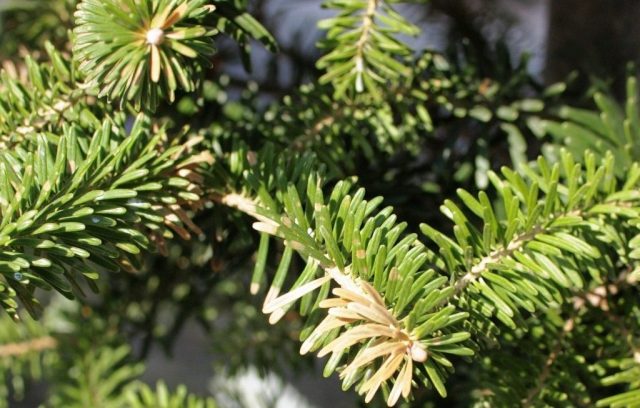

Among insect pests, several groups are traditionally distinguished:
- Sucking (hermes aphids, false shield, spider mite).
- Needle-eating (fir moth, pine moth, fir leafworm).
- Damaging bumps (pine cone moth).
- Root pests (wireworms, beetles).
- Stem pests (black fir barbel, typographer bark beetle).
Insect pests are fought by treating plantings with biological products, as well as various insecticides, acaricides and other means. Spraying of fir trees with various infusions (tobacco, garlic, dandelion) is also widely practiced.
Description of Korean fir and its photo
By the way, it should be borne in mind that the branches of the fir itself should not be used to shelter garden plants. In the spring, a lot of needles remain on them, which does not allow light or fresh air to pass through, which in early spring can be fatal for the covered plants.
Table of Contents
Seeds are sown from the second decade of April. The soil should be sandy loam and loose, a layer of sawdust (2 cm thick) is poured on it. The seeds are spread on the first layer of sawdust, and sprinkled on top with another layer 1-1.5 cm thick (fresh coniferous sawdust is used for it) and watered abundantly.
Growing fir as a business
The constant demand for ornamental coniferous trees makes it possible to consider growing fir in the country as a way of earning money. However, fir can be used not only as an element of landscape design. Fir brooms are very much appreciated by lovers of bath procedures. From the needles of this tree, infusions and oil are obtained, which are used in the treatment of many diseases and are an excellent prophylactic agent. From fir, camphor is obtained, a substance widely used to treat infections of the respiratory tract, lymph nodes and other diseases.
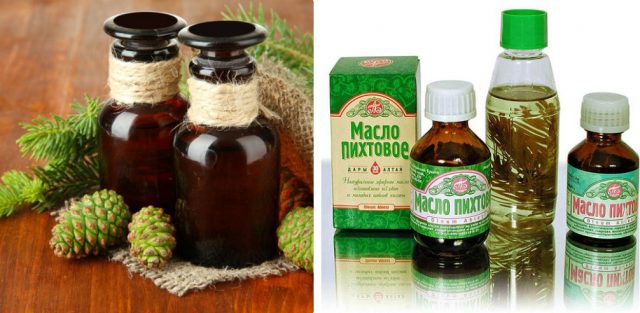

Fir wood is not inferior in quality to pine or spruce. Therefore, it can be used in construction, as well as for the manufacture of various wooden fittings, decorative elements, joinery, furniture.
Care
Especially if the soil is heavy, you need to take care of the drainage, which is made as follows:
Another variety of such a plant, "Piccolo", is very similar in shape to such a variety. However, it has a bluish color with a green tint and the branches are arranged in a radial manner and slightly deviated downward.
Quite successful reproduction of this tree is possible by collecting seeds from cones. Korean fir seeds have a high germination rate.Planting Korean fir seeds should be carried out in the autumn or spring after the seeds have been kept at a certain temperature for a month.
If very severe frosts are observed in the area where the Korean fir grows, and recurrent frosts occur from time to time in the spring, then under any circumstances you should cover the young plant with an additional bedding of twigs of evergreen trees (spruce, pine). You need to cover the tree in full length, this event is especially important in the first year after planting - otherwise it will entail negative consequences. The Korean fir tree will freeze, as evidenced by the blood-red tint of the needles.
Timing of cuttings of fir
To grow a fir with a cutting, it is important to choose the right timing of work:
- at the onset of spring;
- at the beginning of summer;
- at the end of summer;
- in the fall.
The most successful period is the end of winter or spring, when the trees are just beginning to sap. In the southern regions it is March, in colder climates it is April. The resulting cuttings root without problems within a year. For work, choose the morning period or a cloudy day.
It is allowed to postpone the cuttings to June, when the tree is intensively developing. Such planting material in the current season gives only callus. The root system of the culture is developing for the next year.
If the first two stages of cuttings are skipped, then the shoots are cut in August. During this period, their growth stops and desalinization occurs. In September-November, winter cuttings are prepared.
Material harvested in spring and summer can be planted immediately. When collecting cuttings for propagation of fir in the fall, they are kept in a cool room until spring. At the same time, they provide a temperature regime from +1 to +5 ° C and high humidity. It is most convenient to store the material in a plastic container and refrigerator.
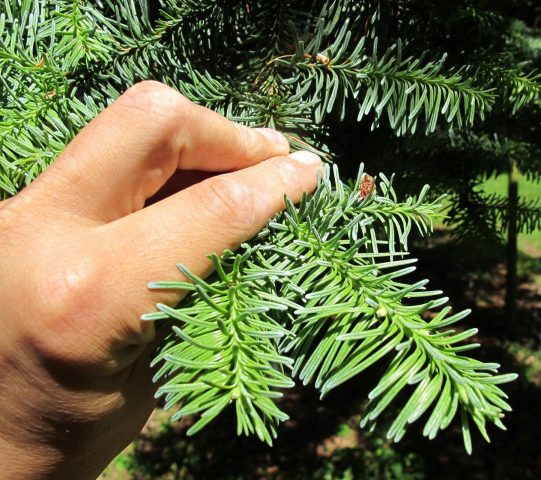

The choice of planting material
Fir is very popular with landscape designers and nature lovers in many countries. You can name many popular species and varieties with their own individual characteristics and differences - these are Sakhalin fir, Violet, Caucasian, Korean, White, Greek, Pretty, Scaly, Graceful "," Great "and many others. On the suburban areas near Moscow, fir "Balsamicheskaya" or "Monochromatic" will take root well.
When purchasing seedlings in the nursery, you must choose only those varieties that are suitable for the area and have a high resistance to frost. It is also recommended to pay special attention to some signs when buying:
- the root system of the seedling should be closed, and the earthen lump should be moist and clean;
- the branches should be elastic, and the ends of the needles should be green;
- age - from 5 to 8 years.
Pruning and shaping the crown


During the cultivation of fir in a pot, many growers in the spring prune the plant so that its crown is neat, regular in shape. Although not necessary. The tree already has beautiful contours. The main thing is that all dried branches should be removed in a timely manner. In autumn, to make the plant more lush, it is enough to pinch the central buds on the shoots.
https://youtu.be/OU-6k_TyCaU
Growing fir in a pot: watering and fertilizing
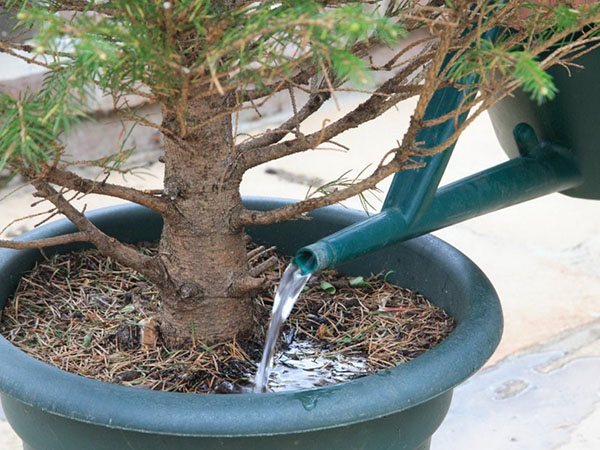

After transplanting the plant, the soil must be well moistened. You can simply put the pot in a bowl of water for 1-2 hours, and then let it drain through the holes at the bottom. Fir is watered as the earth dries up so that water does not accumulate in the pan, otherwise its roots will begin to rot. But it is also impossible to dry out the earthen lump: the tree will grow slowly, the color of the needles will be pale. Water must be poured at the very base of the fir trunk.
It is beneficial to spray the tree a couple of times a week. It is washed periodically under the shower to remove dust. So that moisture does not evaporate so quickly, the surface of the earth can be sprinkled with a small layer of sawdust, mulch from needles.
After about 2 weeks after transplanting, the plant must be fertilized. Especially for coniferous crops, fertilizing is produced in the form of granules. Young plants are rarely fertilized: until the age of two, the fir can not be fed at all, but then it will slowly increase in growth and will be more susceptible to diseases.
Useful tips from experienced gardeners
Several professional recommendations will help beginners grow healthy and beautiful fir:
- Since the lower branches of the fir creep along the ground, if you sprinkle them with humus, they will root themselves.
- In the first 2-3 years, it is important to regularly loosen and weed the seedlings, as well as mulch the ground near them.
- Watering is needed only in hot weather. Mature plants do not need artificial moisture.
- In small areas, it is preferable to plant decorative varieties of fir, growing to a height of no more than 8 m. It is worth paying attention to the following varieties: Elegance, Variegata and Glauka.
Features of growing fir from cuttings at home
To root a fir from a branch, take into account the following features of this process:
- choose the source tree and its shoots correctly;
- comply with the terms of work;
- prepare the substrate;
- provide the required microclimate in the room;
- take care of rooted plants.
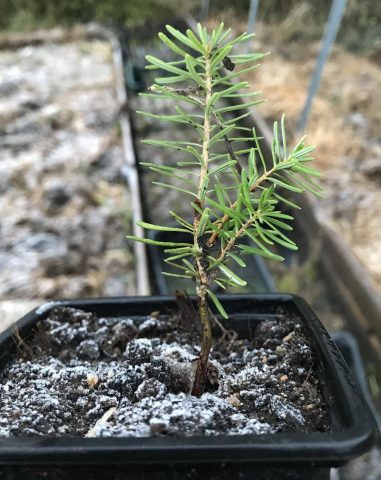

Without processing, cuttings of Siberian, Korean, subalpine, Mayra fir do not take root. One-color, graceful, European species take root best of all. Even after processing, cuttings of subalpine and Arizona varieties do not give roots.
Transplanting a purchased seedling


If a fir seedling was purchased in the winter months, then you should not rush to transplant it. It is necessary to hold it a little in the same conditions in which it grew earlier. If the store or nursery was cool, then the seedling should be placed on the balcony for several days. Then, in the native container, move it to the place where you plan to keep it permanently. And only then should the transplant be started.
Many are interested in how much fir grows. In a pot, it will increase by about five centimeters annually. So sooner or later it will have to be transplanted into open ground. And there she can live for more than a hundred years.
Fir does not like drafts, it is better to choose a cool darkened place for it, but it will grow on a brightly lit window. Before replanting the plant, it must be watered well so that the substrate becomes moist and well saturated with water.
Pot selection


Drainage in a fir pot is required. When the earthen coma is over-moistened and the water stagnant, its roots rot very quickly. For growing fir in a pot, it should be borne in mind that the new container should be 5-10 liters larger than the "native" one. Together with the earthy clod, the seedling is simply transferred into a new container and the required amount of soil is added.
A large pot has a number of advantages:
- the tree in it is more stable;
- the soil remains moist for a long time;
- there is no need to repot the plant often, it is enough to change the pot every 3 years.
The most favorable period for replanting fir is September or October.
Propagation by cuttings


Before growing a fir from a twig, you should know that during vegetative propagation, cuttings take root for a very long time - from several months to a year.
The whole process consists of several stages:
- First, woody adult shoots are selected.
- Cut the cuttings 10-12 cm long.
- The lower part is cleaned from the needles, dipped in a stimulant solution.
- The seedlings are placed in a well-moistened mixture of peat and sand and covered with a film, which is removed only after rooting.
How to propagate fir by layering
To preserve varietal varieties of fir, it is rare, but nevertheless, not only cuttings are used for reproduction, but also layering. This method does not guarantee that the conical shape of the crown will remain. Creeping or crooked plants often grow.But there are practically no worries with this method.
In spring or early summer, it is necessary to bend the branch to the ground and dig in, raising the top. Secure the bend with a wire or weight. Carefully cut off all the branches that have fallen into the ground at the base. Under large branches, make cuts to the wood or wire constrictions. Do not rush to separate the branch from the mother plant, carry it out in stages, gradually cut the junction. Rooting lasts 1-2 years, during this period, maintain an even soil moisture.
The article talked about the fir, the features of its reproduction. Each method has its own advantages and disadvantages. After examining the information provided, you can choose the most suitable one for yourself and easily implement it.


Growing fir in a pot is very fashionable today. An evergreen coniferous tree with a pleasant aroma can be kept in an apartment or a country house and used instead of a Christmas tree. At home, it does not grow as fast as on the street. Fir in a pot grows annually by about 5 cm. It looks great both in the living room and in the office.
For home content, you need to choose dwarf specimens. It is better if these are frost-resistant varieties, then the tree can be kept on the balcony. But it should not be completely open, because the earthen lump and roots in the container freeze faster than in the open field. This must not be forgotten.
Rooting process
A stalk for the prevention of fungal diseases is treated with a fungicide, for example, "Fundazol" (10 g per 0.5 l of water) or a weakly concentrated solution of potassium permanganate. Soak it in a disinfecting mixture for 4-6 hours.
Find out how fir differs from spruce.
To prepare the substrate, take equal parts of the following components:
- sand;
- sod layer of the earth;
- humus.


The container or box is placed in a bright and warm place without drafts. Lighting should be diffused so that direct sunlight does not hit the plant. The shoot is buried in moist soil at an angle of 45 °, by 5-7 cm.
It is recommended to root fir with bottom heatingso that the soil in the container is warmed up to + 20 ... + 22 ° С. The air temperature is maintained in the range of + 16 ... + 19 ° С.
Important! The entire period of rooting, the seedling is provided with a daylight hours of at least 8 hours a day. If necessary, use artificial lighting.
At first, the stalk is under the film. Every day the seedling is ventilated and condensation is removed. For the winter, the container with fir is removed to the cellar or to the heated veranda.... In the spring, it must be taken out to fresh air again.
Twice during the winter, the seedling is fed by adding 10 g of the "Green Needle" preparation, after which it is thoroughly watered.
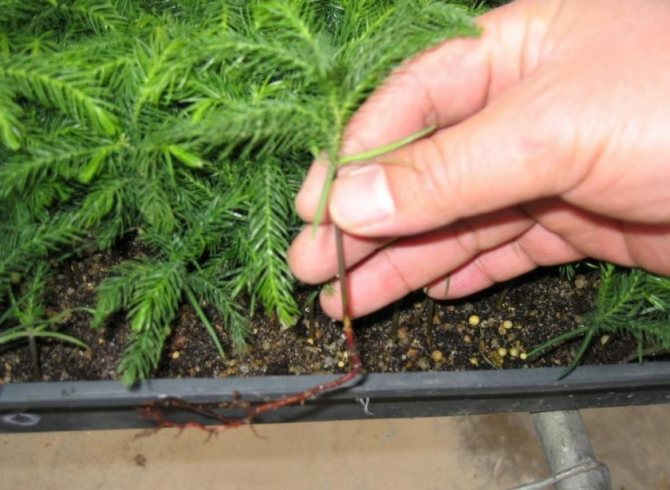

Preparation for wintering
Most of the fir varieties cultivated in the regions of central Russia are quite cold-resistant. However, young specimens need shelter for the winter. It is recommended to cover the trunk circle with peat or spruce branches about 12-15 cm thick.
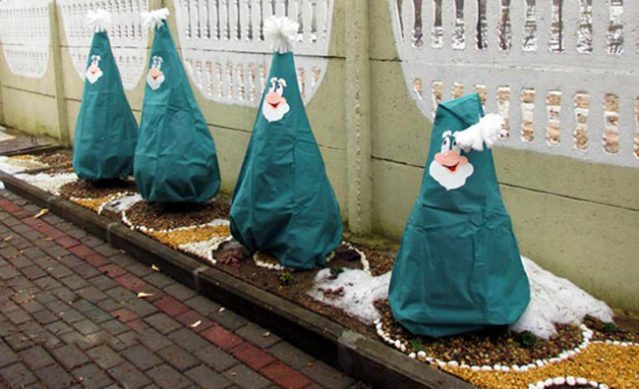

So that young trees overwinter safely, they are covered with any non-woven material.
Mature trees winter well without insulation, but in spring they should be covered with non-woven material to protect them from direct sunlight.
Korean fir: cultivation, reproduction, varieties for the garden.
Similar articles
If there are few cuttings, you can use a mini-greenhouse at home or cover the containers with glass jars, film or plastic bottles cut in half. Also, cuttings are planted in prepared beds in a protected, semi-shady place.
Not all cuttings are suitable for rooting. Since the formation of callus and roots of conifers lasts from several months to a year or more, cuttings that are too thin and weak will be depleted and die long before rooting. Depending on the type of plant, annual lateral shoots of about 5-15 cm in length are taken for cuttings.In vigorous forms of thuja and cypress, cuttings can be 20-30 cm, and in junipers, a little more. Shoots with a "heel" (part of the wood of the previous year) take root well, which are not cut off from the mother branch, but are torn off with a sharp downward movement, capturing part of last year's wood (too long "tail" of the bark can then be cut off with a knife).
It is impossible to imagine a modern estate without conifers. If earlier it was not possible to see a lonely "Christmas tree" at every dacha, today, thanks to the widest assortment offered by garden centers, conifers have become an indispensable component of a garden mixborder and an invariable decoration of any site. True, many are faced with the fact that the price of coniferous planting material, in comparison with deciduous shrubs and trees, is slightly higher and is not always available to ordinary summer residents. Having mastered the simple methods of breeding conifers, everyone can replenish their collection with new varieties and decorate their site with them.
High-quality firs are propagated vegetatively to preserve all maternal traits. The easiest way is layering. The lower branches of fir can give roots when in contact with the soil, even without the direct involvement of the gardener. Rooting takes place within 1-2 years. However, with this method of reproduction, the conical shape of the crown is not guaranteed.
Can infect fir and Siberian silkworm. The defeat by the Siberian silkworm leads to the drying out of trees. Turning into butterflies, the silkworm eats the needles, and then young cones and the bark of thin shoots.
How to plant Korean fir vegetatively? For this, layering or cuttings cut from young plants are taken. It should be borne in mind that Korean fir, reproduction of which is carried out in this way, without treatment with special preparations that stimulate the formation of roots, takes root very badly.
-
Green Carpet
- has darker than the main appearance, purple cones.
It is better to plant seedlings in April or in autumn - in September. The most convenient age for transplantation is 5 - 10 years. They are planted to a depth of no more than 80 cm, the root collar is left at ground level. When planting, it is a good idea to add slow-dissolving mineral fertilizers.Fir is a coniferous evergreen plant belonging to the Pine family. The genus of fir has about fifty species, growing mainly in the temperate climate of the Northern Hemisphere. But for the middle lane, Korean fir is most suitable - slowly growing with a very neat dense crown, a beautiful emerald shade. She comes from the south of the Korean Peninsula, from which she got her name. It grows mainly in the mountains at an altitude of 100 to 1800 meters above sea level, forming mixed or clear forests.
For successful rooting, cuttings need diffused light, intense enough for photosynthesis and the formation in the needles of a special phytohormone necessary for root formation.More often, cuttings are cut with a knife or sharp secateurs, making a cut 0.5-1 cm below the beginning of the lignification site, which can be seen from the transition green to brown. All needles and lateral small branches are removed from the lower part of the cutting (2.5-4 cm from the base or approximately 2/3). The wounds formed on the shoot when they are cut off also stimulate root formation. Try not to damage the apical growth point of the cutting, otherwise the seedling will bush heavily in the future, especially in golden forms. In this way, you can get a large number of plants to create hedges, conifers or fortification of slopes.When fir propagation by cuttings, roots appear at 8-9 months. You need to use only twigs of the last year of life and take them preferably from old plants in early spring at the very beginning of bud awakening.The bottom of the cuttings is cleaned of needles, immersed for several hours in a weak solution of potassium permanganate. They are planted at an inclination of 30 degrees, deepening by 2-3 cm. The simplest version of the soil mixture is compost and sand (2: 1). It is very important to maintain sufficient air humidity. ”For young shoots of Korean fir, the nun silkworm is especially dangerous. These pests eat buds first, and then young needles and pollen of male inflorescences.Young plants are best kept in the shade, as too strong lighting affects them unfavorably. Planting Korean fir involves preliminary drainage. The soil may not be very fertile, it is quite possible to plant Korean fir in acidic soil. If the decisive factor for the gardener is precisely the decorative qualities, the planting of Korean fir should be carried out in soil with a high humus content.Silberzwerg is a creeping form, up to 35 cm high, has dark green, rather short needles. - Fir loves soil fertile, loamy or slightly acidic. Desirable composition: clay, humus, peat and sand in a ratio of 2: 2: 1: 1. On heavy soil, drainage is imperative. To do this, 20 cm of broken brick or crushed stone is poured at the bottom of the planting pit, 300 g of nitroammophoska and 10 kg of sawdust are added.The trees can reach a height of 15 meters. Short, up to two centimeters, shiny needles evenly and densely cover the branches, on which, starting from an early age, amazing purple cones, similar to New Year's toy candles, grow. But they do not live up to the New Year holidays - they fly away in seeds and scales, leaving only bare sharp rods, which also do not stay in place for long. Fir especially bears fruit at a young age.First, you need to make a hole with a wooden peg, and then insert the cutting vertically or at an angle of 45-50 °, depending on the type of parent plant, morphologically with the upper side of the shoot upwards, tightly squeezing the soil around the cutting. Planting depth depends on the size of the cuttings and the breed. More often they are planted to a depth of 1-1.5 cm to 2.5-5 cm.The distance between cuttings in rows is 4-7 cm, between rows is 5-10 cm.After planting, the bed is carefully watered through a fine sieve, trying to wet all layers of soil In open and creeping junipers, 2-3 year old shoots can be used for reproduction, dropping them in sand or loose air-permeable soil for 2/3 of the length. They take root rather quickly (1.5-2 months) and by the end of the season you can get a small bush. In addition to seed (generative) propagation, which, as you know, is not used for varietal plants, since it does not fully retain parental properties, conifers are propagated using cuttings and grafting (propagation by grafting is practiced if grafting is difficult and to obtain standard forms) ... The easiest way, which gives a quick result, is cuttings with semi-lignified and lignified cuttings. The best time to plant is April or August-September. Container plants can be transferred outdoors throughout the growing season. The ideal planting material is 5-10 year old seedlings. The place for the fir should not be chosen in the sun, it is quite shade-tolerant. Korean is not difficult at all and does not involve any special manipulation. 2-3 times a season, it is advisable to water the tree abundantly, if the summer is dry, it is necessary to spray twice a week.- undersized and slowly growing variety, needles of silvery color; round crown with short, abundantly branching shoots - Brilliant With age, Korean fir, like other conifers, becomes more winter-hardy, but in the first winter after planting, the trunk circle must be additionally covered with peat or dry leaves. Young plants also require shelter from the sun - needles can turn red from burns in the spring.
Without cones, Korean fir strongly resembles a spruce, but its needles are flatter, with rounded or notched ends.This tree is almost non-prickly and grows much slower than spruce, has a smooth emerald bark and a tiered arrangement of branches. Compared to spruce, it quickly restores the damaged crown after sunburn.

